France: Modèle 1914 Equipment d'Infanterie de Sangles
Equipment Carriers
POUCH, AMMUNITION
CARTOUCHIERE
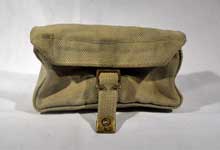
 The Ammunition pouches have sides and bases formed from 2-inch wide web strapping, possibly extended into weather flaps. The front may be a separate section of webbing, but could be in one piece with the back and flap. The flap closes with a ¾-inch strap and buckle. The reverse has a long patch of 2-inch webbing, which secures a pair of “C” clips set near the edges of the Pouch. On Simon’s example, the brace attachment buckle has been removed, but the remaining cut edges show that an inverted “V” of 1-inch webbing was stitched in behind the patch. A 3-bar buckle was secured to this “V”, by being pinched into the fold and stitched. Internally, a second layer of thin webbing is visible, stitched to the inside of the rear face. This may extend all round the interior, as extra waterproofing. It is undivided, which suggests packeted ammunition, not the 3 round clips of the later Berthier Rifle. The soldiers in Simon's 1914 photograph have Lebel rifles, which had a tubular magazine.
The Ammunition pouches have sides and bases formed from 2-inch wide web strapping, possibly extended into weather flaps. The front may be a separate section of webbing, but could be in one piece with the back and flap. The flap closes with a ¾-inch strap and buckle. The reverse has a long patch of 2-inch webbing, which secures a pair of “C” clips set near the edges of the Pouch. On Simon’s example, the brace attachment buckle has been removed, but the remaining cut edges show that an inverted “V” of 1-inch webbing was stitched in behind the patch. A 3-bar buckle was secured to this “V”, by being pinched into the fold and stitched. Internally, a second layer of thin webbing is visible, stitched to the inside of the rear face. This may extend all round the interior, as extra waterproofing. It is undivided, which suggests packeted ammunition, not the 3 round clips of the later Berthier Rifle. The soldiers in Simon's 1914 photograph have Lebel rifles, which had a tubular magazine.
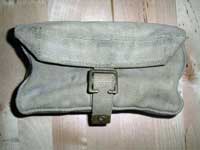
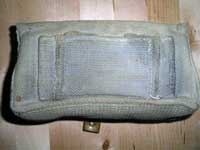
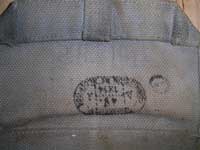 Additional photos of Simon's Pouch. Note that the rear view shows that the brace attachment buckle has been removed, but the remaining cut edges show that an inverted “V” of 1-inch webbing was stitched in behind the patch. The typically French cartouche makers' mark is indistinct, but the 1914 date is clear. The pouch shown above and at left is from the Simon Braillon Collection, photographs © Simon Braillon 2010.
Additional photos of Simon's Pouch. Note that the rear view shows that the brace attachment buckle has been removed, but the remaining cut edges show that an inverted “V” of 1-inch webbing was stitched in behind the patch. The typically French cartouche makers' mark is indistinct, but the 1914 date is clear. The pouch shown above and at left is from the Simon Braillon Collection, photographs © Simon Braillon 2010.
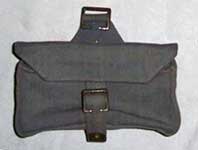
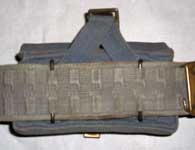 Another example of the Ammunition pouch, from the Eric Baradon Collection. This Pouch is complete and retains its top buckle and inverted “V” of 1-inch webbing. Photos © Eric Baradon 2010.
Another example of the Ammunition pouch, from the Eric Baradon Collection. This Pouch is complete and retains its top buckle and inverted “V” of 1-inch webbing. Photos © Eric Baradon 2010.

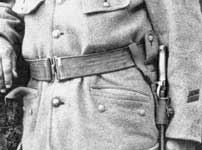 Typically, French Bayonet frogs had double belt loops, here reproduced in webbing and fitted with a webbing strap and buckle, which secured through the horizontal scabbard loop of M-1886 “Rosalie” bayonet, in the usual French manner. We have not seen a surviving example of this type of Frog in webbing, but one is pictured in Martin Brayley's 2005 book, BAYONETS: AN ILLUSTRATED HISTORY. The owner of the photograph shown in Martin's book, Robert Stedman, has graciously allowed us to use it here as well. However, he has asked that it not be copied, please.
Typically, French Bayonet frogs had double belt loops, here reproduced in webbing and fitted with a webbing strap and buckle, which secured through the horizontal scabbard loop of M-1886 “Rosalie” bayonet, in the usual French manner. We have not seen a surviving example of this type of Frog in webbing, but one is pictured in Martin Brayley's 2005 book, BAYONETS: AN ILLUSTRATED HISTORY. The owner of the photograph shown in Martin's book, Robert Stedman, has graciously allowed us to use it here as well. However, he has asked that it not be copied, please.
There is a second design of Frog, of Patt. ’25 proportions and pointlessly fitted with a press-stud, as with Patt. ’25, but with a solid scabbard loop. The scabbard staple sits on top of this web loop, the ½-inch strap passing from inside the Frog, through the metal staple and down to the frog buckle. The example shown above right is from the Eric Baradon Collection. Photo © Eric Baradon 2010.
BOTTLE, WATER
BIDON
With only one spare Brace end available, it seems unlikely that there was a framework Carrier for the water bottle, with its filling & drinking spouts. In the 1914 photograph, black straps are visible, on which the bottle was carried, this being borrowed from the existing leather equipment. The crossed bottle and haversack slings fly in the face of Mills’ practice, which was to free the chest of compressing straps.
Rog Dennis, August 2010